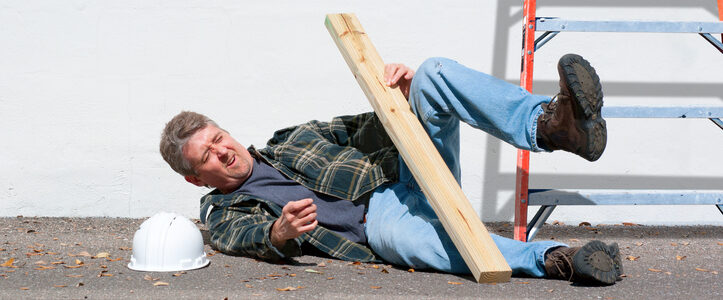Falling from a height can cause serious, even life-threatening injuries depending on how far a victim falls. For example, falling from a roof can produce severe head trauma and/or a damaged spinal cord. Whether you work on a construction site or in an office, it is important to understand how to prevent falls from heights that might happen anywhere.
Common Causes of Falls from Heights
The most common height to fall from is between six and 10 feet. A fall from this distance accounts for 25 percent of all deaths that are associated with falls from heights. Whether you use ladders every day or for one-off tasks, you are still at risk of falling. Here are some of the causes of falls from heights:
Carelessness
Working at any height, even if just a couple of feet high, should be taken seriously. However, some victims of falls from heights become complacent when performing routine tasks or putting the finishing touches on a project at work. Carelessness is often the result of working from heights for many years without sustaining the injuries caused by a fall. Stay focused on the task at hand, with an acute awareness of following safety protocols.
Fatigue
Most workplaces implement standards that prevent workers from becoming fatigued and thus, placing themselves in harm’s way. One prime example concerning the focus on preventing fatigue applies to truckers who must stop driving after a certain period has passed. Fatigue often leads to making poor decisions, which can contribute to a mistake that causes a fall from a height.
Fast Work Pace
The urge to work at the same pace from a height of several feet as you work when you are on the ground can lead to a fall. Workers that make a living on the ground are particularly vulnerable to falling from heights if rushed by a project manager. Tight project deadlines can force employees to move faster when they work from a height of several feet.
How to Help Prevent a Fall When Working at a Height
If there is one word that should describe the mindset of someone working from heights, it should be caution. The increased risk of sustaining one or more injuries should be a good enough reason to change the way you work above ground level.
Let’s review some tips to help prevent falls from heights.
Identify Potential Hazards
Knowing what might cause a fall from a height before reaching the place where you plan to work from can prevent a serious fall. For example, if you work as a roofer, you should examine your workplace to identify any materials that might cause you to fall. If you climb a ladder to reach a place to work, you should identify any objects nearby such as a tree or balcony that might affect your climb and cause you to fall.
Take Your Time
Since rushing through an above-ground project can cause a fall from heights, the remedy to this issue is to take your time. Even if you fall behind on a project at work, resist the temptation to pick up the pace if you work several feet above the ground. This means conducting meticulous inspections of the above-ground work environment before you start to work on a project.
Take Breaks
Taking regularly scheduled breaks should prevent the onset of fatigue. Taking a break should entail coming down from the height where you are working. It is not enough to pause for a few minutes while you remain several feet above the ground.
Stay Current with Safety Guidelines
Employees that work in high-risk jobs should receive frequent training that concerns workplace safety guidelines. Your manager should emphasize the importance of understanding any changes that have been made by your company and/or a government agency. For example, the Occupational Safety and Health Administration (OSHA) requires companies to provide fall protection from elevations of four feet in general industry workplaces, five feet in shipyards, and six feet in the construction industry.
Make Sure Your Ladder is Ready for Use
It is important to always choose the right ladder for the job. Keep in mind the weight the ladder will have to hold and the height you are trying to reach. Remember, extension ladders should extend three feet above the platform you are trying to reach. Always remember to inspect the ladder before use and to not use the ladder if any damage is noticed. Ladders get thrown in and out of trucks and closets which may cause the ladders to get beat-up. A damaged ladder is unsafe to use and should be immediately taken out of service. If you notice any cracked or damaged uprights, braces, or rungs, the ladder should not be used. Loose nails, screws, bolts or other metal parts are also a huge red flag. The ladder rungs should be secure and clean of any oil or dirt. Foot treads should not be worn out and all of the ladder’s labels should be present and legible. It’s also important to make sure the ladder is stable before climbing, and never place the ladder on an object to gain additional height. If the ladder is rocking even slightly, or if you need something underneath the feet of the ladder to keep it stable, the ladder is unsafe for use.
Watch the Weather and Wear the Right Equipment for the Job
Do not climb ladders in rainy or windy weather, and at all times, slip-resistant shoes should be worn while climbing. Never carry tools in your hands while climbing; instead, wear a tool belt and always maintain three points of contact.
Performance and Load Capacity
Consider the demands and load capacity of the ladder. A ladder with the appropriate performance level and duty rating should be selected. For example, a worker using a ladder on a regular basis while carrying or wearing heavy equipment should choose a ladder with a higher duty rating versus someone using a ladder on a less frequent basis for small tasks.
The Bottom Line
Falling from a height of just a few feet can produce catastrophic injuries such as brain trauma and compound fractures. To prevent a devastating fall from heights, follow a few time-tested tips that include working at a moderate pace and taking enough breaks to prevent the development of fatigue. Staying safe protects your health and can help protect your fellow employees from having a workplace injury and claim.
There for You: Acadia Insurance
At Acadia, we’re all about helping businesses throughout the Northeast thrive. Our mission is to provide superior service and product as close to you as possible, providing you with the backing you need to proceed with confidence.
We understand what you want most from your insurance is security and peace of mind. That means knowing you are backed by an insurance company who will support you every step of the way to help you protect your business.
With Acadia, not only can you get coverage tailored to your needs, but you will also receive support from dedicated claims professionals to guide you through the claim process in the event of a loss. That way, you know exactly what to expect. Knowing your claims professional by name and a hand shake – that’s “Closer Coverage”. Get to know more about how we work and find an agent near you.
Acadia is pleased to share this material for the benefit of its customers. Please note, however, that nothing herein should be construed as either legal advice or the provision of professional consulting services. This material is for informational purposes only, and while reasonable care has been utilized in compiling this information, no warranty or representation is made as to accuracy or completeness. Recipients of this material must utilize their own judgment in implementing sound risk management practices and procedures.




